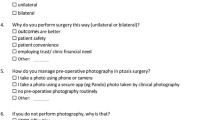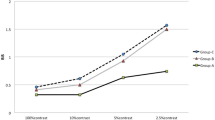Abstract
Purpose
It is vital that surgeons undertaking oculoplastic procedures are able to show that the surgery they perform is of benefit to their patients. Not only is this fundamental to patient-centred medicine but it is also important in demonstrating cost effectiveness. There are several ways in which benefit can be measured, including clinical scales, functional ability scales, and global quality-of-life scales. The Glasgow benefit inventory (GBI) is an example of a patient-reported, questionnaire-based, post-interventional quality-of-life scale that can be used to compare a range of different treatments for a variety of conditions.
Methods
A cross-sectional study was undertaken using the GBI to score patient benefit from four commonly performed oculoplastic procedures. It was completed for 66 entropion repairs, 50 ptosis repairs, 41 ectropion repairs, and 41 external dacryocystorhinostomies (DCR). The GBI generates a scale from −100 (maximal detriment) through zero (no change) to +100 (maximal benefit).
Results
The total GBI scores of patients undergoing surgery for entropion, ptosis, ectropion, and external DCR were: +25.25 (95% CI 20.00–30.50, P<0.001), +24.89 (95% CI 20.04–29.73, P<0.001), +17.68 (95% CI 9.46–25.91, P<0.001), and +32.25 (95% CI 21.47–43.03, P<0.001), respectively, demonstrating a statistically significant benefit from all procedures.
Conclusion
Patients derived significant quality-of-life benefits from the four most commonly performed oculoplastic procedures.
Similar content being viewed by others
Log in or create a free account to read this content
Gain free access to this article, as well as selected content from this journal and more on nature.com
or
References
Carr AJ, Gibson B, Robinson PG . Measuring quality of life: is quality of life determined by expectations or experience? BMJ 2001; 322: 1240–1243.
Leong SC, Karkos PD, Burgess P, Halliwell M, Hampal S . A comparison of outcomes between nonlaser endoscopic endonasal and external dacryocystorhinostomy: single-center experience and a review of British trends. Am J Otolaryngol 2010; 31: 32–37.
Federici TJ, Meyer DR, Lininger LL . Correlation of the vision-related functional impairment associated with blepharoptosis and the impact of blepharoptosis surgery. Ophthalmology 1999; 106: 1705–1712.
Bergner M, Bobbitt RA, Carter WB, Gilson BS . The Sickness Impact Profile: development and final revision of a health status measure. Med Care 1981; 19: 787–805.
Hunt SM, McEwen J, McKenna SP . Measuring health status: a new tool for clinicians and epidemiologists. J R Coll Gen Pract 1985; 35: 185–188.
The EuroQol Group. EuroQol - a new facility for the measurement of health-related quality of life. Health Policy 1990; 16: 199–208.
Ware JE, Sherbourne CD . The MOS 36-item short-form health survey (SF-36). I. Conceptual framework and item selection. Med Care 1992; 30: 473–483.
Robinson K, Gatehouse S, Browning GG . Measuring patient benefit from otorhinolarynhological surgery and therapy. Ann Otol Rhinol Laryngol 1996; 105: 415–422.
Feretis M, Newton JR, Ram B, Green F . Comparison of external and endonasal dacryocystorhinostomy. J Laryngol Otol 2009; 123: 315–319.
Bakri SJ, Carney AS, Robinson K, Jones NS, Downes RN . Quality of life outcomes following dacryocystorhinostomy: external and endonasal laser techniques compared. Orbit 1999; 18: 83–88.
Smirnov G, Tuomilehto H, Kokki H, Kemppainen T, Kiviniemi V, Nuutinen J et al. Symptom score questionnaire for nasolacrimal duct obstruction in adults - a novel tool to assess the outcome after endoscopic dacryocystorhinostomy. Rhinology 2010; 48: 446–451.
Spielmann PM, Hathorn I, Ahsan F, Cain AJ, White PS . The impact of endonasal dacryocystorhinostomy (DCR), on patient health status as assessed by the Glasgow benefit inventory. Rhinology 2009; 47: 48–50.
Ho A, Sachidananda R, Carrie S, Neoh C . Quality of life assessment after non-laser endonasal dacryocystorhinostomy. Clin Otolaryngol 2006; 31: 399–403.
MacAndie K, Kemp E . Impact on quality of life of botulinum toxin treatments for essential blepharospasm. Orbit 2004; 23: 207–210.
Kafil-Hussain N, Khooshebah R . Clinical research, comparison of the subjective visual function in patients with epiphora and patients with second-eye cataract. Orbit 2005; 24: 33–38.
Bhattacharyya N, Tarsy D . Impact on quality of life of botulinum toxin treatments for spasmodic dysphonia and oromandibular dystonia. Arch Otolaryngol Head Neck Surg 2001; 127: 389–392.
Draper MR, Salam MA, Kumar S . Change in health status after rhinoplasty. J Otolaryngol 2007; 36: 13–16.
Calder NJ, Swan IR . Outcomes of septal surgery. J Laryngol Otol 2007; 121: 1060–1063.
Salhab M, Matai V, Salam MA . The impact of functional endoscopic sinus surgery on health status. Rhinology 2004; 42: 98–102.
Author information
Authors and Affiliations
Corresponding author
Ethics declarations
Competing interests
The authors declare no conflict of interest.
Additional information
Parts of this work have previously been presented at academic meetings.
Rights and permissions
About this article
Cite this article
Smith, H., Jyothi, S., Mahroo, O. et al. Patient-reported benefit from oculoplastic surgery. Eye 26, 1418–1423 (2012). https://doi.org/10.1038/eye.2012.188
Received:
Accepted:
Published:
Issue date:
DOI: https://doi.org/10.1038/eye.2012.188
Keywords
This article is cited by
-
8-0 polyglactin 910 suture in entropion repair: long term follow up and rates of recurrence
Eye (2023)
-
Exploring correlations between change in visual acuity following routine cataract surgery and improvement in quality of life assessed with the Glasgow Benefit Inventory
Eye (2018)
-
Assessment of patient-reported outcome and quality of life improvement following surgery for epiphora
Eye (2017)
-
Anterior approach white line advancement: technique and long-term outcomes in the correction of blepharoptosis
Eye (2017)
-
Long term patient-reported benefit from ptosis surgery
Eye (2015)



